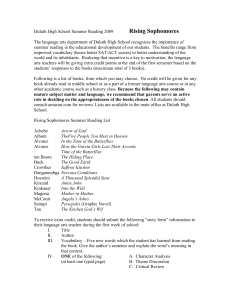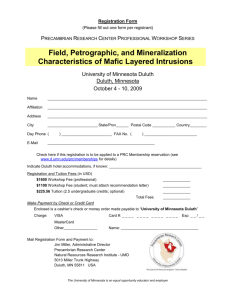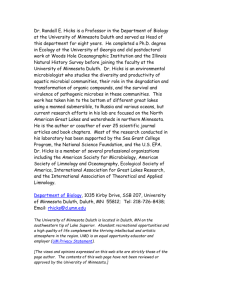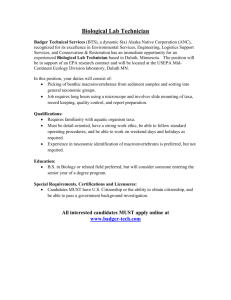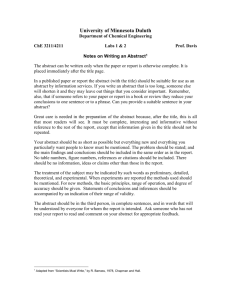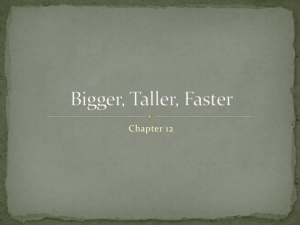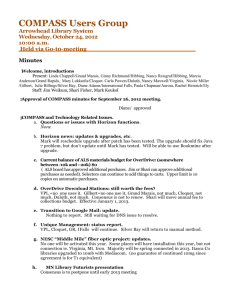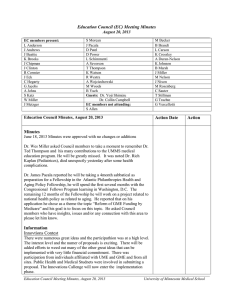Education Council (EC) Meeting Minutes September 16, 2014
advertisement
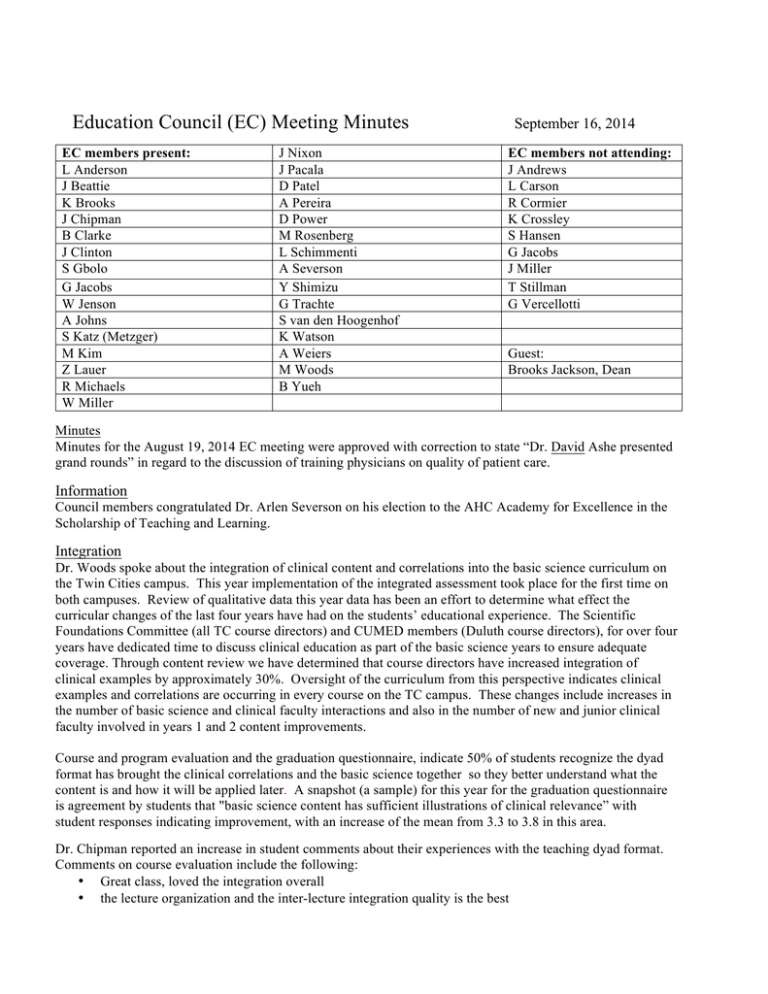
Education Council (EC) Meeting Minutes EC members present: L Anderson J Beattie K Brooks J Chipman B Clarke J Clinton S Gbolo G Jacobs W Jenson A Johns S Katz (Metzger) M Kim Z Lauer R Michaels W Miller J Nixon J Pacala D Patel A Pereira D Power M Rosenberg L Schimmenti A Severson Y Shimizu G Trachte S van den Hoogenhof K Watson A Weiers M Woods B Yueh September 16, 2014 EC members not attending: J Andrews L Carson R Cormier K Crossley S Hansen G Jacobs J Miller T Stillman G Vercellotti Guest: Brooks Jackson, Dean Minutes Minutes for the August 19, 2014 EC meeting were approved with correction to state “Dr. David Ashe presented grand rounds” in regard to the discussion of training physicians on quality of patient care. Information Council members congratulated Dr. Arlen Severson on his election to the AHC Academy for Excellence in the Scholarship of Teaching and Learning. Integration Dr. Woods spoke about the integration of clinical content and correlations into the basic science curriculum on the Twin Cities campus. This year implementation of the integrated assessment took place for the first time on both campuses. Review of qualitative data this year data has been an effort to determine what effect the curricular changes of the last four years have had on the students’ educational experience. The Scientific Foundations Committee (all TC course directors) and CUMED members (Duluth course directors), for over four years have dedicated time to discuss clinical education as part of the basic science years to ensure adequate coverage. Through content review we have determined that course directors have increased integration of clinical examples by approximately 30%. Oversight of the curriculum from this perspective indicates clinical examples and correlations are occurring in every course on the TC campus. These changes include increases in the number of basic science and clinical faculty interactions and also in the number of new and junior clinical faculty involved in years 1 and 2 content improvements. Course and program evaluation and the graduation questionnaire, indicate 50% of students recognize the dyad format has brought the clinical correlations and the basic science together so they better understand what the content is and how it will be applied later. A snapshot (a sample) for this year for the graduation questionnaire is agreement by students that "basic science content has sufficient illustrations of clinical relevance” with student responses indicating improvement, with an increase of the mean from 3.3 to 3.8 in this area. Dr. Chipman reported an increase in student comments about their experiences with the teaching dyad format. Comments on course evaluation include the following: • Great class, loved the integration overall • the lecture organization and the inter-lecture integration quality is the best • • • • • I’d like to see more of the dyad teaching, when you get taught by a PhD there are always clinical application questions that come up, having someone who can answer them in class is very helpful. Enjoyed the clinical correlation, the dyad approach with the two is fantastic and very interesting. success depends on dyad team members’ ability to respond to each other’s approach ability to work in tandem to deliver an integrated course requires preparation ahead of the joint lecture For one course, while on call, the clinician who actively taught as part of a dyad, emailed the co-director with details of a case he was working on. The medical issue involved acid based physiology and because it fit with the lecture for the following day, the basic science co-director refined the case. Their combined efforts resulted in a very dynamic and detailed set of information that impacted the problem when students participated in the lecture. Students responded with strong positives for the quality of the learning experience with collaboration between the two faculty. Having a physician at the lecture provided relevant clinical information, related to the basic science topic they studied that day. There has been an increase in a shared format for planning for the dyad based sessions. This is happening more often, but isn’t standard across all courses. In cases where there may be one person presenting the majority of the content, there are a number of people involved in discussion of content which strengthens courses. • Microbiology has a dyad format; due to co-course director planning, working together and adapting, it evolves and improves. • The Microbiology course planning is deliberately designed to include expertise from several disciplines. • This year a facilitator for Yr-1 FCT has observed students’ synergy and timing with FCT sessions and what is being taught in the other Yr-1 courses. • Students recognize that topics and content are linked across courses. • Linkage with other course work was a planning focus last year and this year • Greater effort to send FCT case content, goals and objectives to course directors before FCT occurs. • FCTs purpose is “how to find the right answer”; course directors do not want to change the value of the critical thinking objectives. • Students have a new level of comfort with subject matter • Different courses have used varying mechanisms; some work well, others adaptations are still evolving. The dyad approach does require a significant time commitment and dollars are budgeted to compensate the departments that have faculty involved and responsible for the dyadic format. In other situations there are those stand-alone course directors with whom we have 1-year contracts for course director responsibilities. Integration Assessment Dr. Chipman noted an assessment has been developed and administered to determine how well the Yr-2 students can connect the classroom experience to a clinical situation. With POCC, FCT and course content as part of the picture, the goal is to measure whether they could apply their knowledge to patient care. SimPortal was used to administer to test for both the TC and the Duluth students, the test used a pulmonary physiology simulation case found in Med Ed Portal. The team took the SimPortal to Duluth using the same trained “raters” who are paramedics. The assessment tool was created in conjunction with faculty and evaluators in Duluth, it assesses history taking, physical exam, how well they communicated and professionalism. The paramedics served in the role of nursing staff in the emergency room setting. Last Spring semester 170 TC students and 60 Duluth students took the test. In reviewing the results there was very little difference between the Duluth and TC students in evaluating the domains, except the Duluth students did slightly better on the diagnosis. Duluth students use integration as an integral part of their pathophysiology learning. All testing took place in exactly the same way and their performance was impressive. The Duluth students performed better on pneumonia in the areas of identifying the deteriorating status and their overall scores were statically significant. When looking at the internal consistency and reliability, they were reasonable for a low stakes developmental feedback exam, improved rater training should help to increase the reliability of the exam. There were several doctors who reviewed videos and scored them; the actual inter-relater reliability was high. The process and functionality work well over the two campuses, the goal is to improve the rater reliability and for now it will be used as a low stakes developmental feedback exam. A goal for the future is to improve the reliability and to make it a higher stakes exam. Feedback from students on both campuses was good, indicating they enjoy this format for skills testing. For the TC students, to this point they haven’t had much experience with simulation and the Duluth students had had more opportunity with this type of training environment and examination. Dr. Suzanne van den Hoogenhof spearheaded the testing through SimPortal and led the process to give students this experience. She was present for all of the testing and reported on the positive feedback from students. Two new cases will be developed for the examination for the 2014-15 AY and the “rater” training will be improved and increased before those exams. Dr. Chipman spoke about scholarship for those involved in development, adding the rating will be submitted to Med Ed Portal and there will be further work done to submit a paper related to developing reliability. The exam assesses integration by exposing the students to a clinical environment through SimPortal. Areas where they’re challenged in a clinical situation include: • deal with performing a physical exam and history, order diagnostics, recognize the deteriorating physiologic status • determine “what is the next step” • use basic science knowledge gained over years 1 and 2 • requires student to make choices and perform steps that lead to a decision/diagnosis • use critical thinking skills to apply their basic science knowledge • required to apply the knowledge to a clinical situation • process what the simulation exam is presenting for them to solve Dr. van den Hoogenhof pointed out that while students were processing different possibilities the raters would ask them to determine what steps they would take to confirm each of their possible diseases. As background for the Duluth Curriculum, one of their courses is Clinical Medicine. Within their curriculum integration each course has some aspects of Clinical Medicine that’s directly related to the individual organ system. Each block of a course has at least one simulation which students are required to study. Each course has a clinical course director in addition to the basic science course director; the clinical course director is responsible for planning. The respiratory block has PBL in it and each PBL wrap-up session is led by a physician. Those in Duluth feel the SimPortal exam is a very good program and would welcome having it repeated this year (dates are set). Dr. Anne Pereira, Assistant Dean for Clinical Education, talked about steps to include more basic science in the practices students experience in the clerkship rotations. She recommends pharmacology, anatomy, physiology, pathophysiology and microbiology; should all be present in the Year 3 and 4 curriculum. An important question is how to accomplish implementation of the basic sciences across all required clinical courses. Answers could include: • “flip classroom” techniques • readings to do in preparation for the specific clinical experience • some “teach the teacher” requirements Dr. Yoji Shimizu, Director of MSTP, added that the objective in this program is to integrate basic science and clinical medicine throughout the entire training sequence. Students in the MSTP, during their first two years while they are taking basic science coursework • attend weekly research meetings • journal club discussions and research experiences • graduate phase includes some clinical activities • required to give a clinical grand rounds presentation • Discuss a case and at the backend they include basic science underlying the disease/inform current or future options for treating the disease. • Ongoing discussion to determine how to keep existing integration of basic science and clinical. Many of the MSTP students focus entirely on their clinical training in the last 2 years, but there are opportunities to do a research elective. Some students do elect to incorporate research experience into their clinical training, work is in progress to determine how to formalize these experiences and make them apparent to students as a possible option for continued research. Dr. Miller encouraged finding a method to help the MSTP and PSTP residents bring their basic science expertise to the clinical experience to demonstrate how that is applied to patient care. Evaluation letters do identify the value their training brings to clinical experiences. Discussion Dean Jackson also attended the meeting and shared his top priorities in education. He highlighted the following specific areas: 1. Student Debt is too high. He pointed out that the average debt for a graduating Minnesota medical student is approximately twice that for a graduating Johns Hopkins medical student. The deficit in scholarship money available here is a major issue. Although we are keeping tuition stable, this will be insufficient to fully address the problem. 2. Programs which shorten medical education (such as the Pediatric program we are piloting) may help to address both debt and workforce needs. 3. Student Diversity: With a goal for our class demographic to reflect that of the state, our newly admitted class is about half way to that goal for Underrepresented In Medicine matriculants. We have made significant progress under the leadership of Dimpel Patel and Robin Michaels. We are losing outstanding UIM candidates to top institutions who have more scholarship availability. 4. Student Scholarly Activity needs to be encouraged and expanded. Our dual goals of producing primary care and academic physicians are not mutually exclusive and, in fact, we want to produce academic physicians who are excellent clinicians and primary care physicians who have experience and expertise in applying research to patient care. Expansion of the MD/PhD program (MSTP) is a potential future goal. 5. Educational Scholarship: Our faculty should seek national recognition and reputation through educational innovations and research which is published in peer-reviewed journals and web sites. We should seek to be evidence-based as we improve our approach to medical education. 6. Educational facilities: We need an AHC Education Building and this is part of our capital request to the State. Next Meeting, October 21, 2014 4-5:30 B646 Mayo
